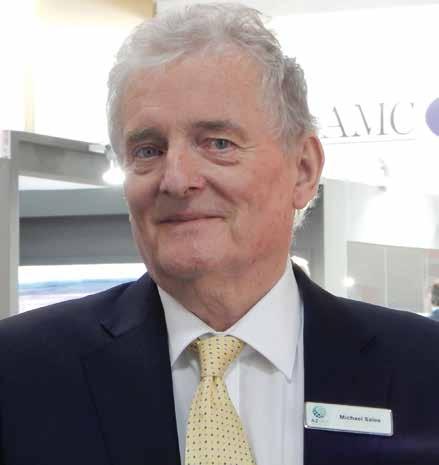
5 minute read
Providing digital access to truck parking space around Amsterdam Airport Schiphol
by Cargomedia
A solution for wrongly parked vehicles and queues of trucks waiting to access their docking station. Fewer unnecessary kilometres driven by truckers searching for a place to wait or park in an unfamiliar area. And an easy way to find a safe place to rest or uncouple a trailer. These are a few advantages of digitally facilitating parking locations for trucks in a busy environment such as the Amsterdam Metropolitan Area. Within Connected Transport Corridors program, the Amsterdam Westkant corridor, Royal Schiphol Group and Be-Mobile are starting to digitally map parking and waiting locations in the Schiphol Cargo World area.
Text Anke Hoets, Amsterdam Logistics Photography Elmer van der Marel
Advertisement
TP3, or Truck Parking 3, on Folkstoneweg in Schiphol-Zuidoost, is the scene of the action. This well-lit, paid parking facility has space for 70 trucks. Drivers can take a shower, do laundry and rest as they wait to continue their journey to their airport destination. Erik Felëus of Schiphol Commercial adds: “They can do so in the knowledge that TP3 is a closed site with CCTV surveillance.” At present, drivers who manage to find their way to TP3 have to wait and see if there is space. But in a digital age, it doesn’t have to be that way, explains Janneke Nijsing, programme manager of CTC Amsterdam Westkant. In recent months she has been closely involved in developing what she describes as the ‘truck area digitisation showcase’. “In a practical trial taking place in the coming months, we’ll be laying the foundation for a data sharing system for parking and waiting sites. The showcase demonstrates how data sharing could work for parking and waiting locations. We hope the result will be a realistic analysis of opportunities and bottlenecks for the digitisation process.”
Testing in practice
The method is to provide access to static and dynamic data on matters such as location, opening hours, available facilities, charges and the total number of parking spaces. The static data is publicly available, managed by the Netherlands Vehicle Authority
(RDW) in the National Parking Register. The current research aims to determine how data should be shared for freight transport, what data is necessary and available, and how it can be shared in real time, for example in an app, as is already the case for car parking management. Be-Mobile is making the live status of the number of available places available in the Truckmeister app, which is already well-known in the logistics sector. Wallborn will be the first carrier in the Amsterdam Metropolitan Area to use it. “With the app we’re investigating whether the data chain can be used in practice,” Janneke Nijsing says. “We show which locations are available, and whether they meet the wishes of the logistics sector. As soon as drivers arrive in the Schiphol area, they receive an automatic notification of parking or waiting locations that are currently available. Once they click on the notification, they are automatically shown the route so they can navigate to it.”
Clean, smart and safe transport around Schiphol
Various organisations are taking part in the showcase. They have a shared ambition to make the transport and logistics sector more sustainable and future-proof: clean, smart, efficient and safe. “We see a huge amount of traffic on the roads at and around Schiphol,” says Erik Felëus, “and we’re using digital resources to improve accessibility by road for visitors to our cargo buildings, offices and hotels. In this showcase, we’re encouraging truckers who arrive early at the airport to use TP3 so that they don’t have to wait unnecessarily in the road at their destination.” In addition to mutual goals the participants also have ambitions of their own with regard to the showcase. Amsterdam Airport Schiphol aims to establish whether the app can be designed to make data provided only accessible to traffic with specific destinations at Schiphol. Schiphol also hopes data sharing will offer a solution to prevent congestion caused by trucks arriving to pick up or drop off cargo at the airport site. If for example a handling agent indicates that no space is available for a truck the airport wants to be able to offer the driver an alternative waiting area. As part of the national network of Connected Transport Corridors (CTC) CTC Amsterdam Westkant is especially interested in the added value of the application: can the data be uses for other applications in the logistics sector and what changes to the data chain will be needed to make the methodology scalable.
Using data for analysis and operational management
In addition to the practical implementation, there are questions regarding the use of the data: which data is stored where? What conditions apply, and who is responsible for data management? Also, to measure is to know: accessing the data relating to truck traffic may be an important instrument for analysis and control, both in the vicinity of the airport and elsewhere, says Janneke Nijsing. “Transport hubs like the port and airport in Amsterdam need insight into their queues of trucks in order to be able to control them. Insight can be created by combining information about dock schedules and expected arrival times of carriers. How big will the queue be and where can drivers wait safely? It reduces disruption and contributes to efficiency in the logistics chain. Because if parties in the transport hubs can manage operationally on the occupation of the waiting locations, they will be able to also manage other matters in the future, for example pre-reception.” Besides that, access to the data is an issue if third parties want to use it in the future to develop the app further for queue management.

Widely applicable new method
The showcase will run throughout 2021. Based on their experiences, the participants will draw up a road map for functional use cases that can be deployed more widely. “We hope that in the future, truckers will no longer have to drive to Amsterdam Airport Schiphol and TP3 hoping there will be a parking space available, but that they can reserve it in advance”, says Janneke Nijsing closing with a promise: “Once there is a solid methodology in place, we expect to be able to roll it out more widely.”










